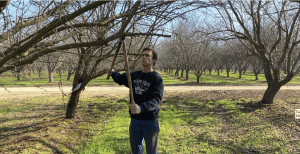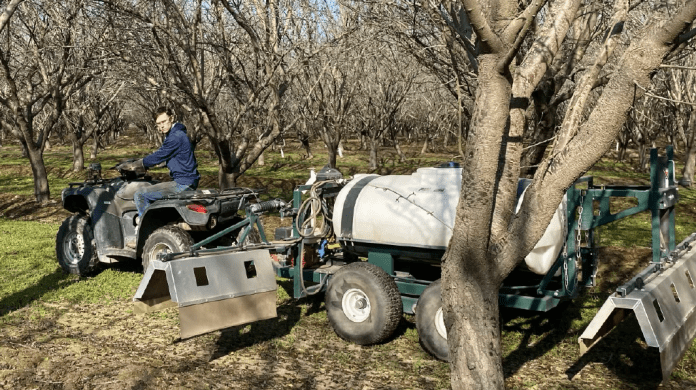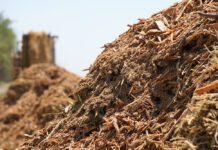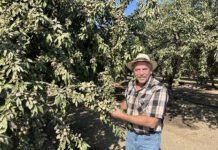It would be a good bet that the FFA member named the American Star Farmer 2022 has never been an almond grower.
Peter Bliss, a 2020 graduate of Golden Valley High School in Merced and an almond grower, beat the odds last October when he became the winner of this prestigious award at the National FFA Convention in Indianapolis.
The American Star Farmer Award is given to the FFA member who demonstrates the top production in a supervised agricultural experience. Bliss is only the third California FFA member in the 95-year history of the National FFA Organization to be selected as the American Star Farmer.
“They really didn’t ask me much about my almond production. They stuck with questions about cotton and wheat (his other supervised agricultural experience projects) that they are more familiar with,” Bliss said in a recent interview with West Coast Nut.
Bliss’ agriculture teacher and FFA Advisor Cody Jacobsen said Bliss and his farming projects have been on the radar of the state FFA organization since he was named the state star farmer in 2020. He also has won two national FFA proficiency awards for fiber and oil crops and diversified farming, competing with FFA members from across the nation.

“Lives and Breathes Farming”
“He just stands out with his actual farming experience. He lives and breathes farming,” Jacobsen said. He explained that the Star Farmer award is meant for the FFA member who demonstrates that they are in charge of their enterprise, make the decisions and do the work.
California FFA members may have some unique challenges that FFA members in other parts of the country don’t often encounter. Jacobsen said their production costs are higher and they must deal with more restrictive environmental regulations.
During the interviews for the award, California FFA members have to educate the interviewers about permanent tree crops in California, Jacobsen added. Interviews done on Zoom do not tell the entire story about a student.
“If they met him in person and shook his hand, they would know he really does all the work.”
Bliss’ 105 acres of almond trees in the El Nido area are a big part of his farming efforts. The land is leased from his family, and Bliss said he helped plant many of the Monterey and Nonpareil trees at the age of six.
He is a fifth-generation farmer and also grows cotton and wheat.

Crediting Farming Mentors
Besides Jacobsen, Bliss counts his father, and a neighbor, Scott Heupel, as his farming mentors.
“I look to them as well as neighboring almond growers for advice and information about taking care of this orchard,” he said. “The best advice I have been given is if it doesn’t make sense, it won’t make dollars.” Bliss said he applies that advice to all the financial decisions he makes for his operation. He budgets for the upcoming year by looking at previous year’s expenses and income. Those numbers, he said, will determine what he can or can’t afford to do in the next year. Bliss said that recently, those numbers have been challenging.
Heupel, an almond and walnut grower in Merced County, said he has watched Bliss grow into a “hands-on” kid who decided early on in his high school years to move to a program that matched his farming ambitions. Heupel, who was coaching the farm power team at Golden Valley, said Bliss won the state farm power contest as a junior and continued to work on his FFA experiences.
“Pete is going to be a farmer for the rest of his life,” Heupel said of his young neighbor.
Heupel said Bliss has an incredible work ethic, which is why Heupel asked him to come work for him parttime.
“We talk about almonds and varieties and general farming practices like fertilization, pest management and why we do the things we do in farming, practical things we all have to learn.
“You can’t make a lot of mistakes in farming and continue to farm,” Heupel said.
Bliss said the toughest lesson to be learned in almond production is the effect weather can have on the crop. Weather at bloom can dictate how the entire growing season goes.
Keeping up with irrigation and pest control means he must be vigilant and watch the trees closely. Postharvest is a part of the year when he is crunched for time; just as the almond harvest is wrapping up, he said it is time for cotton harvest to begin. At the same time, he is also dealing with pollination contracts, limited water availability and increased restrictions on pesticide use.
Bliss said he has a PCA on board to recommend applications, but he said he was not sure how cutting back on pest and weed control due to restrictions on use will affect his production.
He is also in the process of finding a new pollination service provider this year.
The water situation is making him nervous, Bliss said. His trees are in the Chowchilla Irrigation District, but he hasn’t received surface water deliveries in the past two years. With upcoming groundwater pumping restrictions, he is concerned about his ability to irrigate and avoid stressing the trees and keep up production.
Last year was his first growing season with a drip irrigation system, converting from flood irrigation in the orchard. Bliss said the change was a positive one for orchard health and his ability to meet water needs more precisely. The result, he said, was higher yield than previous years. It also meant that he no longer had to change water at all hours of the night, an important consideration when you are also the head irrigator.
Bliss said with the drip system, kernel size improved. He explained that his ground includes an old river site, making it harder to push water through some parts of the orchard with flood irrigation. The sandy streaks were tough dirt, he said, but with the drip system, he saw much improved growth.
Bliss said he receives feedback on his crop quality from his processor after harvest, and they take time to talk about the markets and where his crop sits in the market. He said current plans are to stick with the Nonpareils as they are easier to sell. Pulling and replanting trees are not in his immediate future; Bliss said that decision will rest on the price of almonds in the future.

Cecilia Parsons | Associate Editor
Cecilia Parsons has lived in the Central Valley community of Ducor since 1976, covering agriculture for numerous agricultural publications over the years. She has found and nurtured many wonderful and helpful contacts in the ag community, including the UCCE advisors, allowing for news coverage that focuses on the basics of food production.
She is always on the search for new ag topics that can help growers and processors in the San Joaquin Valley improve their bottom line.
In her free time, Cecilia rides her horse, Holly in ranch versatility shows and raises registered Shetland sheep which she exhibits at county and state fairs during the summer.
















